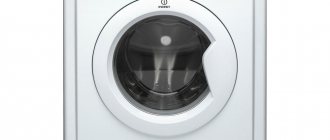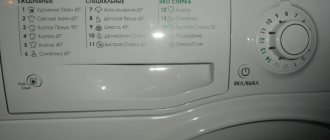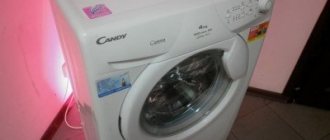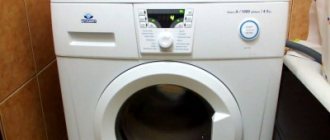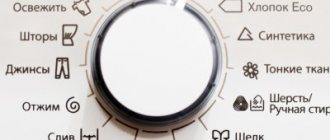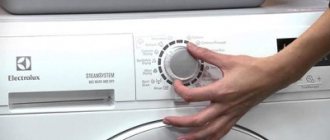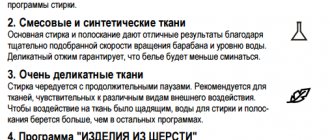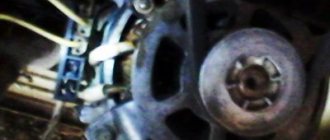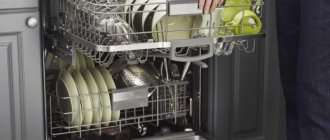Today, even a child can use a washing machine: load the laundry, add powder, select a mode and press start. It would seem that everything is very simple. However, it is ignorance of the basic operating rules that often leads to the fact that you do not get the desired effect from washing. We decided to figure out how to properly use a washing machine and how to care for it.
Ignorance of basic operating rules often leads to the fact that you do not get the desired effect from washing. Let's figure out how to use a washing machine correctly
How and why do you need to sort clothes before washing?
Why sort clothes before washing?
The first thing to do is find the label on the clothing. He will tell you how to wash this or that item. There is a reminder on the shirt on the inside left or near the collar. On the trousers - inside at the back. For example, some things shrink from hot water. Others can only be washed with bleach. This is what the label will tell you about.
Before you start using the washing machine, start the wash cycle and set aside items that say “hand wash” or “dry clean”. They cannot be washed in a machine.
Preparing things
After sorting, you need to check your pockets: take out money, documents, shake out small debris. Turn out the rolled up sleeves of shirts, lined trouser legs, jeans, remove pins and brooches.
Small items, underwear made of thin fabrics, bras are placed in special bags - the metal half-rings will not get stuck in the machine and the underwear will not tear.
To reduce the appearance of pilling and carefully wash the front side of things, the clothes are turned inside out and placed in the washing machine. Do the same with pillowcases and duvet covers.
Preparing laundry
Turning on and starting the washing machine
How to turn on the washing machine correctly?
After you have sorted the items by color and weight, you can directly start using the washing machine. To do this, you need to turn it on. How to do this is always indicated in the instructions. We will also give some practical tips:
- Connect the machine to the sewer and pipeline.
- Check your drainage system to avoid flooding yourself or your neighbors.
- Press the power button on the control panel.
- Pour the powder into a special container or place the cap filled with liquid powder directly into the drum.
- Select a mode or manually adjust the temperature, spin, and wash time.
- Launch the selected settings.
Drum loading
The amount of textiles washed depends on the size of the drum. The equipment has restrictions on the weight of laundry per wash from 5 to 20 kg , depending on the model. It is also not recommended to stuff the machine up to the permissible weight. So it works in an enhanced mode, which will lead to wear faster. Therefore, the best option would be to weigh things, but a small percentage of housewives resort to such an event.
Bedspreads with complex textures and padding polyester blankets are not always easy to load into the drum. To do this, you need to roll it lengthwise several times and twist it into a roll. You need to twist it tightly so that the blanket fits into the loading hatch. It will unfold on its own in the drum.
What is the optimal washing temperature?
The right temperature for washing
Choosing the right temperature for washing depends on the fabric:
- Silk, wool and other delicate fabrics are washed at 30 degrees. Cold water takes better care of them and does not harm them.
- Bed linen and curtains can be washed at 30-40 degrees.
- Dirty children's clothes and towels can be placed at 40-60 degrees.
- They remove difficult stains and also disinfect linen and toys at a temperature of 95.
But before you choose the washing temperature manually, look at the label on the items; it has the optimal temperature at which the items will remain clean and not spoil.
Understanding the washing machine modes
How to choose the right mode when washing?
Set the washing mode on the control panel. Or it can be installed using a knob that needs to be turned and fixed to the desired program. For example, there is such a regulator if you use a Bosch washing machine.
Popular modes: “Cotton”, “Synthetics”, “Bulky items”, “Delicate”, “Baby clothes”, etc. I.e. By choosing any mode, you do not need to manually adjust the temperature, spin and washing time. Many housewives prefer quick wash, this is a mode in which things are washed in half an hour.
After selecting the program, all you have to do is start the washing machine. Let's take a closer look at some universal modes.
"Delicate"
Based on the name, it is clear that you need to use a washing machine with this mode for special things: thin, light fabrics. This mode simulates hand washing; the drum swings easily, with little impact on the fabric.
"Fast 30"
This mode is suitable if you need to refresh things or remove light dirt. Washing time is usually 30 minutes. At the same time you save energy, powder and water. In total, features of the mode:
- Choose it for rinsing things.
- Suitable for both colored and black clothes.
- Saves resources.
Main functions
For better washing, most washing machines have the ability to select additional functions, which include:
- Spin. Using this function allows you to spin your laundry separately at the speed you require.
- Drain. The use of this function is indicated in situations where you need to drain the water from the machine, but there is no need to rinse or spin the laundry.
- Makes ironing easier. A similar function, present in many machines, will allow you to get clothes that are not too wrinkled after washing. A peculiarity of the operation of the device when this function is turned on is that it skips the intermediate spin cycle and uses a slightly larger volume of water for rinsing.
- Half load. Thanks to this function, you can save on washing in situations where there is not too much laundry accumulated, but it needs to be washed urgently. After loading the machine halfway and activating this function, the washing duration will be reduced.
- Delayed activation. This function is especially valuable for busy people, as it allows you to load laundry and detergent, and set the program to start at the selected time. Typically, this function is used to get washed clothes in the morning or before returning from work.
- Rinse delay. This function is in demand in situations where it is not possible to remove items from the machine immediately after washing. Enabling this function will retain water inside the device until the owner of the equipment turns on the drain or spin cycle.
- Additional rinse. Enabling this feature will add an extra rinse to your wash cycle. This function will be useful for allergy sufferers or parents of small children, as it will allow them to better clean clothes from detergent residues.
- Rinse and drain. Enabling this function separately allows you to rinse any clothing and then spin it.
- Disabling spin. The use of this function is relevant for things that can be damaged during the spin process. The machine will skip the spin cycle and end the program without it.
- Water level control. If such a function is available and activated, the device will determine the amount of laundry in the tank, and then fill the tank with water in the required amount, due to which water will be used more economically.
- Child protection. Enabling this function will prevent the machine from opening during the washing process.
What powders and other products should I use?
How can you wash things in a washing machine?
How clean yours will be depends not only on the washing machine, but also on the powders you use. Our recommendations:
- Choose powders that are machine washable and also look at the type of fabric (indicated on the packaging).
- Wash white items with bleach powder. This will help not only get rid of dirt, but also return things to their original white color.
- On the contrary, wash colored items without bleach so that they do not lose their brightness.
- Between dry and liquid products, choose liquid ones, because... they contain more active substances and are easily removed from things.
- If a stain remains after washing, try bleach (for whites) and stain remover (for colors).
- To keep things soft after using the washing machine, add not only the powder, but also the rinse aid.
Is it necessary to wash new bed linen?
Many housewives are wondering whether they need to wash new bed linen or whether they can use it right away. Newly purchased items look so good that you don’t want to wash them. But this impression is deceptive.
In fact, during the production process, fabric is picked up by people, dust settles on it, and it passes through various equipment. So washing new clothes is necessary . For the first wash, you should choose the highest permissible temperature in order to disinfect the laundry, get rid of the specific smell of new fabric and remove dye residues.
New linen should be put on the bed only after washing.
So, you need to wash your bed linen in the machine at least once a week. To select the correct wash cycle, check the manufacturer's care instructions label.
How to use washing machines of different brands?
Instructions for Indesit
How to use an Indesit washing machine?
If you use an Indesit washing machine and cannot find the “Start” button, then do not be alarmed. Some models actually do not have such a button. And first you need to select a mode, etc., and then press the “On/Off” button.
The rules for using an Indesit washing machine look like this:
- Open the hatch and put things in the drum. However, do not load it completely; the door should close without additional effort.
- Add powder and other products.
- Turn on the machine using the “Power” button.
- Set the mode or temperature and spin speed.
- You can also switch to another mode already in progress.
Tray compartment features
According to the type of loading, all automatic washing machines are divided into two types - vertical and front loading. The first model includes unloading laundry through the top compartment of the machine, while the second compartment is located on the side. The location of the tray for unloading washing powder and other products is also located in different places:
- for equipment with a vertical type of unloading, the compartment is located in the upper part, on the left side, but in some models it can also be found on the right side;
- In front-loading devices, the compartment is located on the front wall, under the top cover, most often on the left side.
The detergent tray most often includes three separate compartments. But this type of design is not typical for all devices: there are models where there are no compartments at all, but special devices are installed, which include five compartments. If there are no compartments, then it is not recommended to add rinse aid to the tray.
If we consider simple models, it is important to note that all three compartments will differ from each other in size. Each of them will have its own purpose.
The wider compartment is used for the main wash. It contains detergent in the amount that corresponds to the instructions. Such a compartment on devices is most often indicated by the following symbols B, 2 or II. The medium-sized compartment is designed for soaking. If soaking is not required when washing things, then no powder is added to this section. Such a department has the following designations A, 1 or I.
The machine also has the smallest compartment, into which the fabric softener is poured. Above it is most often an asterisk, a flower, the letter C or the number 3, III. Often, the manufacturer installs a blue plastic fence above such a section.
In some machines, such a compartment can be additionally divided into two parts, one of which is created specifically for air conditioner, and the other for bleach and liquid starch. In some devices, such a compartment can be removed from the tray itself.
If there is no marking in the tray, and all other sections look the same, then to understand what to do, it is best to use the special instructions for the device or go online. If this does not help, then you can go to the store, find the same model of machine and ask the employee for all the necessary details.

